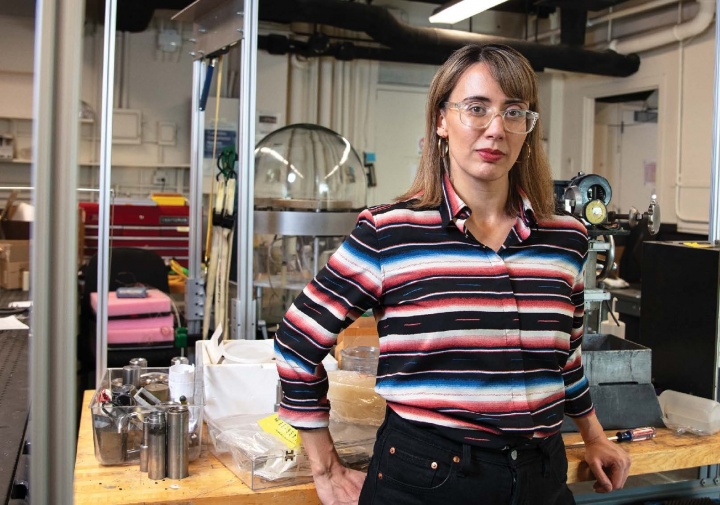Columbia College | Columbia University in the City of New York
Kerstin Perez ’05

Jörg Meyer
“I’m essentially an instrument builder, and I’m making tools that have never existed,” Perez says.
For nearly a century, physicists have been trying to solve the mysteries of dark matter, which Perez patiently explains is a type of material that creates gravity but doesn’t interact with light. Scientists have noted that something is exerting force on the universe and producing the structures they observe, like galaxies; but without light, it can’t be seen with standard astronomical instruments.
And that’s where creative thinking comes in. Perez, an experimental particle physicist, believes one way to get closer to identifying dark matter is to develop tools to either detect it or rule out what it’s not. “Every time we measure something new about the universe, we learn something we didn’t know before,” she says. “Maybe we don’t find dark matter, but we could eliminate some things we thought were dark matter.”
Perez and her team are currently collaborating on an experiment that will release a balloon from Antarctica in December to seek out and measure cosmic particles above the atmosphere. She calls it “a sort of fishing in the universe,” looking for answers to what it might be made of.
Asked how it feels to study something so profoundly enigmatic, Perez is philosophical. “Essentially, all of the science we have ever measured — all the biology, all the particle physics, all the astrophysics, all the chemistry — all of that addresses about 20 percent of the universe,” she says. “And the other 80 percent? We don’t know what it is. That’s a pretty big problem — and so far, there isn’t an end result. But I guess that’s what it is to be a scientist.”
Born and raised in West Philadelphia, Perez thought she would study fine arts but had an avid high school physics teacher who passed on his enthusiasm; notably, she also liked the challenge of it. She earned a Ph.D. from Caltech in 2011, spending four years investigating dark matter at CERN in Geneva. She returned to Columbia as an NSF Astronomy and Astrophysics Postdoctoral Fellow before joining the faculty at Haverford College in 2015. She later was faculty at MIT for six years before returning to Columbia in 2022.
In all of her faculty roles, Perez has especially valued connecting with students, and is gratified to feel like she has particular influence, both as a woman and as a Mexican American. “A lot of students have said it’s inspiring to see me in control of the classroom,” she says.
It’s a feeling Perez remembers from being an undergraduate herself. “Listen, physics is hard for everyone,” she says. “But when you look around the room and see no one who looks like you, you can feel like an outsider. And if you feel like you don’t belong, it’s that much harder to go to a professor’s office hours, or form a study group, or raise your hand to ask questions — to do all of those things that we know make you successful. It’s an extra burden to carry around.”
Promoting inclusivity and setting students up for success in STEM classes is a priority for Perez, and she has been advocating for change as a member of the recently formed Committee for Science Instruction. Her particular passion is adapting introductory classes to retain as many interested students as possible. “There is evidence within our own community that we are doing things that dissuade students from pursuing their passion for physics,” Perez says. “And it’s differentially impacting the students who are already historically excluded from the field — women, Black students, first-gen students or students at the intersections of all of these. So what can we do to improve that? How do we make sure that all students who are interested in these disciplines are supported?”
Perez believes that introductory classes are both the most demographically diverse and also where professors have the most potential to reach students, and so she was looking forward to teaching introductory physics for the first time (at Columbia) this spring. “I think it is my responsibility to give students the tools to be a successful physics major,” she says. “And when you make these choices to improve your classroom for everyone, it really does raise everybody up,” she says.
Because ultimately, in the pursuit of dark matter and that unknown 80 percent of the universe, creative thinkers are needed. “We absolutely do have to fulfill the promise of educational equality,” Perez says. “But thinking about it selfishly from the science, we need as many brains as possible.”
Issue Contents
Published three times a year by Columbia College for alumni, students, faculty, parents and friends.
Columbia Alumni Center
622 W. 113th St., MC 4530, 6th Fl.
New York, NY 10025
212-851-7852
cct@columbia.edu
Columbia Alumni Center
622 W. 113th St., MC 4530, 4th Fl.
New York, NY 10025
212-851-7488
ccalumni@columbia.edu

